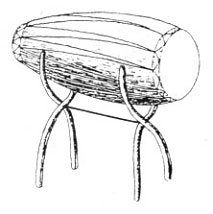shuangmiangu overview
 Double-sided drum (pinyin: Shuāng miàn gǔ), also known as double-sided drum. Dai people's mixed percussion-membrane musical instruments. The Dai language is called Guangsa, Guangbian and Guangbang. Popular in Yunnan Province Xishuangbanna Dai Autonomous Prefecture, Dehong Dai and Jingpo Autonomous Prefecture and other places. Playing double-sided drums varies by region.
Double-sided drum (pinyin: Shuāng miàn gǔ), also known as double-sided drum. Dai people's mixed percussion-membrane musical instruments. The Dai language is called Guangsa, Guangbian and Guangbang. Popular in Yunnan Province Xishuangbanna Dai Autonomous Prefecture, Dehong Dai and Jingpo Autonomous Prefecture and other places. Playing double-sided drums varies by region.In the Dai area of Xishuangbanna, the drum belt is hung around the neck, the drum body is placed horizontally in front of the abdomen, the left hand slaps the thick-end drum surface, the right-hand slaps the thin-end drum surface, and dances while hitting. This is the popular "Guangsa Dance", which is mostly performed by groups. In the Dai area of Dehong, the drum belt is hung on the left shoulder, the drum body is transverse to the left side of the abdomen, the thick drum face is facing the right front, each hand holds a drum, the left hand hits the thin drum face at the back, and the right hand hits the drum face. The front thick-end drum surface also dances while hitting. Although the double-sided drum has no fixed pitch, the two ends have different pronunciations, the thin end is high and the thick end is low.
In the Dai area, during festivals or festive harvests, men, women and children of the whole village come to the courtyard dam, beat the double-sided drums, sing and dance happily, and are accompanied by musical instruments such as cymbals, Dai cymbals and Guangtun. The dance steps are slow and neat, and the mood is cheerful and enthusiastic. Sometimes day and night, all night long.
- Pinyin:Shuāng miàn gǔ
- nickname:two-sided drum
- type:Dai nationality mixed percussion sounding instrument
- length:100cm~120cm
overview of other similar instruments
- sanyanxiao overview
- Daguangxian overview
- Leiqin overview
- hahao overview
- yandundagu overview
- Han Xiaozheng overview
- Fang Xiang overview
- guanzi overview
- zhuqin (Dao Qin) overview
- zhuiqin overview
- bangzi overview
- three-stringed piano overview
- Gehu overview
- xiao overview
- xiaokonghou overview
- Konghou overview
- Sheng overview
- suona overview
- hulusi overview
- gushao overview
 渝公网安备 50010702504639号
渝公网安备 50010702504639号